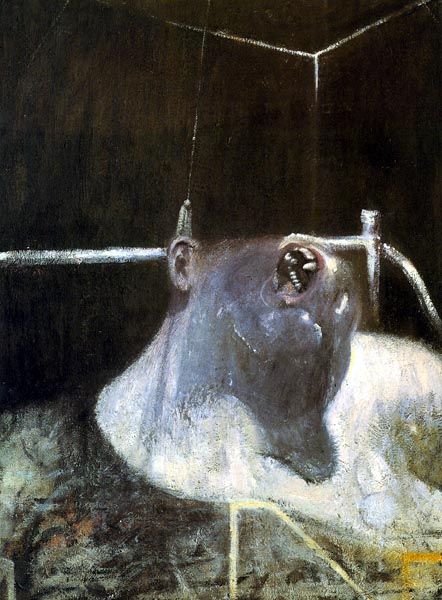Art Gallery of New South Wales
17 November 2012 - 24 February 2014
 |
| Crucifixion (1933) |
Contemporary thinking suggested that for art to be meaningful, it had to be abstract, but Bacon was fascinated with the human form and with flesh. His figurative compositions are still bold, confronting and intense. The exhibition of half a century’s work opens with Crucifixion (1933), a ghostly black and white depiction of a human form with an X-ray quality. Less a spiritual symbol than an emblem of human brutality and suffering, this manipulation of the human form, inspired by Picasso, is a recurrent theme throughout his art.
In the 1940s and the final years of WWII, Britain was shattered by profound violence and destruction. Bacon was excused from active military service (due to his asthma) but worked for the Civil Defence. He paints many screaming figures, gasping for air, crouched beneath umbrellas or enclosed in cage-like structures and claustrophobic boxes. Much has been written about the symbolism of the scream; is it a cry of pain, an asthmatic gasp or even a cry of orgiastic ecstasy?
He was also profoundly influenced by the silent film Battleship Potemkin, directed by Sergei Eisenstein, particularly the shot of a screaming nurse with broken glasses and bloodied face on the Odessa Steps. Furthermore, he was affected by a book on diseases of the mouth and wrote, ‘I like the glitter that comes from the mouth... I’ve always hoped to paint the mouth like Monet painted a sunset’.
The open-mouthed image frequently appeared in his artwork, including the Head series. Bacon paints heads rather than faces, rubbing and brushing the face itself until it loses form. He substitutes black shadows and voids for where the body might be. These paintings blur the line between human and animal; the fangs suggest aggression but the expression hints at deep suffering. He emphasises the emptiness above the heads, using delineated boxes to cut down the scale of the canvas and direct the eyes down to the image.
 |
| Head I |
 |
| Study after Velasquez's Portrait of Pope Innocent X |
Many of Bacon’s works of this period feature figures in awkward postures in cubes, as those displayed as exhibits of torture or go-go girls. Men in blue suits are trapped against pin-striped backgrounds like conformist attire or circus tents – cabined; cribbed, confined. Francis Bacon was homosexual in an era where it was outlawed (it was not officially decriminalised until 1957) and perhaps his figures are subject to torture that is mental, physical, and sexual.
He was inspired by photos of supposed ectoplasm and ghostly forms, echoed in his tropes of white prisms, frames, contortionism and crouching nudes: a crouch being a posture that implies oscillating energy, squeezed into a ball ready to burst outwards. His insistence on gilt frames gave the work status and suggested value, combining subversion with respectability. Bacon also liked to have his paintings shown under glass, which forces the viewer to confront his own reflection in the midst of the painting, thus negating distance and detachment.
Study from the human body (1949) displays striking tenderness alongside a gentle erotic charge, as a figure steps through a transparent curtain. The painting suggests both depth and mystery as we ponder themes of imprisonment, concealment, danger and homosexuality. Bacon’s own comments are designed to obfuscate: “I would like my pictures to look as if a human being had passed between them like a snail leaving a trail of the human presence and memory trace of past events as the snail leaves its slime.”
 |
| Study from the human body (1949) |
 |
| Two Figures (1953) |
 |
| The End of the Line (1953) |
Figure with Meat (1954) is a masterpiece of composition. The dry brush marks of red, orange, cream and blue that depict the carcasses flank the authoritative male figure in purple/blue. Bacon said without discernible irony, “We are meat. We are potential carcasses. If I go into a butcher’s shop I always think it’s surprising that I wasn’t there instead of the animal.”
 |
| Figure with Meat (1954) |
 |
| Untitled (half-length figure in sea) (1953-54) |
 |
| Study for a running dog (1954) |
 |
| Untitled Dog (1967) |
 |
| Figure in Landscape (196-57) |
No comments:
Post a Comment